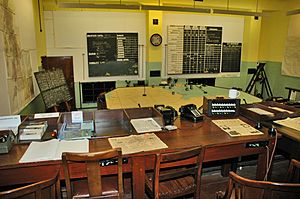Sector clock facts for kids
A Sector clock was a special round clock with different colors. It was used at military airfields and observation posts in the United Kingdom. Its main job was to help track enemy aircraft and guide friendly planes during wars.
What is a Sector Clock?
A sector clock is a unique timepiece designed for military use. It has a face marked with red, yellow, and blue triangles, each covering five minutes. It also shows both 12-hour and 24-hour times. These clocks were super important for air defense, especially during big conflicts like World War II.
History of Sector Clocks
These clocks were first used during World War I in 1917 by the Royal Flying Corps. They were called "colour change clocks" back then. Their purpose was to help keep an eye on German aircraft movements.
Later, during World War II, sector clocks played a huge part in the famous Battle of Britain. They helped the Royal Air Force (RAF) and the Royal Observer Corps (ROC) track planes. Even after the war, they were used until the end of the Cold War. Today, these clocks are popular items for collectors who like aviation history.
There were two main types of sector clocks made. One was for the RAF Sector, and it had a special "King's Crown" RAF symbol on its face. The other type was for the ROC, and it had a plain face without any symbol. Some clocks were electric, and their colored segments pointed inwards. Others were mechanical, and their segments pointed outwards. The United States Army Air Force also started using similar clocks, but their colored sections were blocks instead of triangles.
How Sector Clocks Helped

Before computers, sector clocks were key to something called Ground-controlled interception (GCI). This was how people on the ground guided fighter planes to intercept enemy aircraft.
Here's how it worked:
- When an enemy plane was spotted, its position was recorded.
- At the same time, the color of the triangle under the minute hand on the sector clock was noted.
- This information, including the color, was sent to a central headquarters.
- At headquarters, a large map of the UK was laid out on a table.
- Small colored counters, matching the clock's colors, were placed on the map to show where each enemy plane was.
- As the planes moved, people used magnetic "rakes" to push the counters across the map.
- This simple system let "Fighter Controllers" quickly see where enemy planes were going. They could also tell how old the information was by the counter's color. This helped them make fast decisions about where to send friendly fighter planes.
See also


